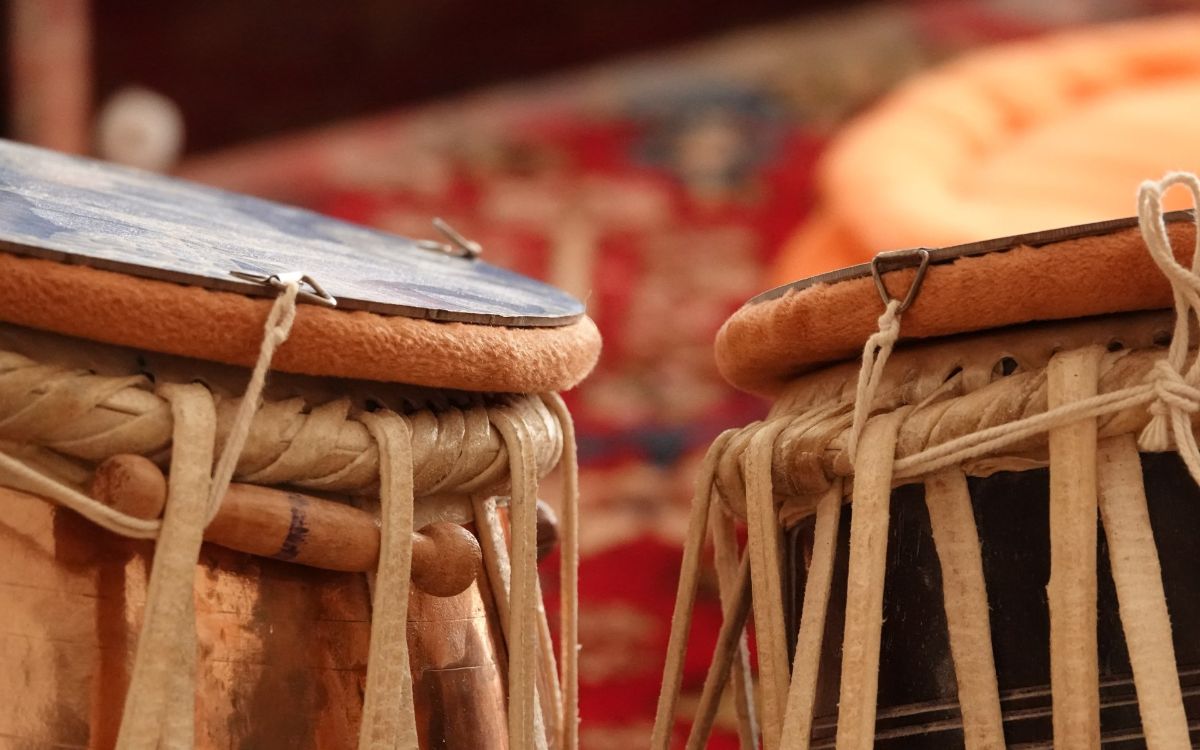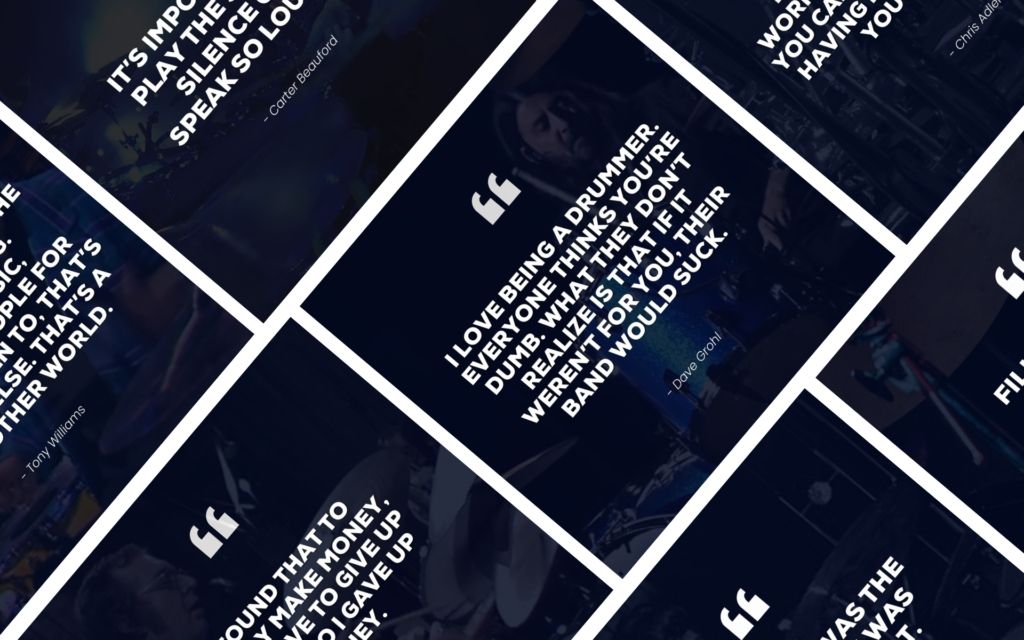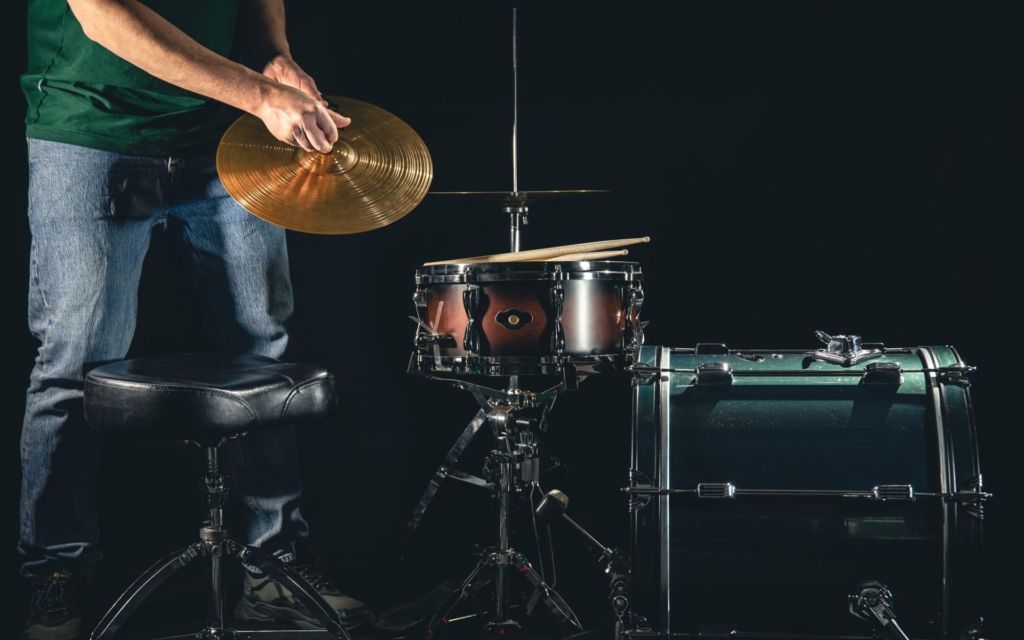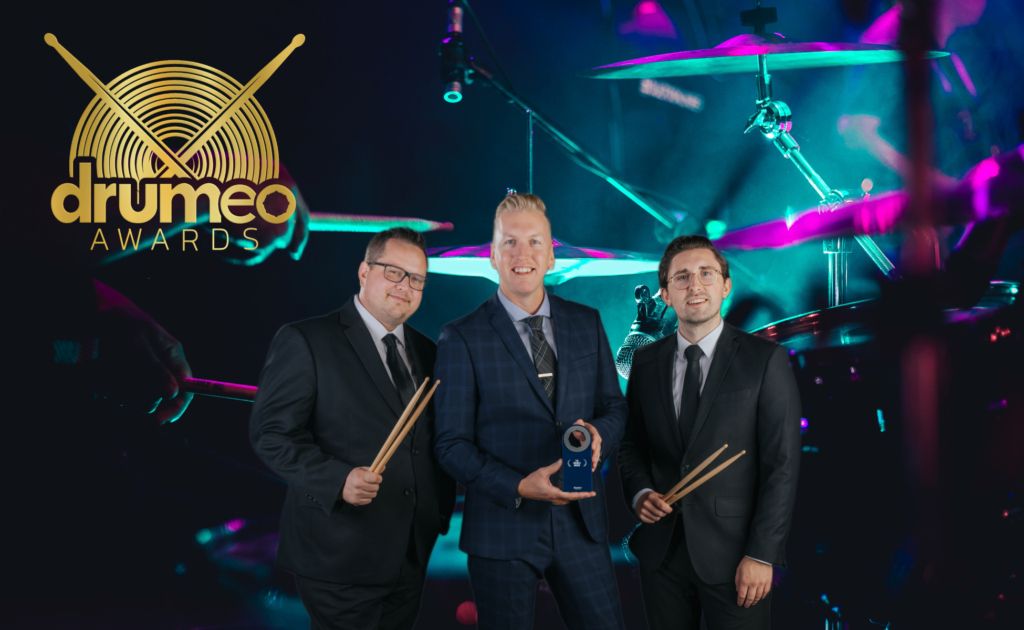Since anything you hit with your hands or a drumstick to make noise can be considered a percussion instrument, there are a considerable number of popular percussion instruments from all over the world.
However, you can also find some rather weird drums that you may have never heard of before. We’re going to look at 10 of these unusual percussion instruments from around the world!
Contents
Unusual Percussion from Around the World
Glass Harmonica
A glass harmonica, also known as the glass armonica or simply the armonica, is a musical instrument invented by Benjamin Franklin in 1761.
It consists of a series of glass bowls or goblets of different sizes mounted on an axle. The bowls are arranged in order of size, with the largest at the bottom and the smallest at the top.
To play the glass harmonica, the musician wets their fingers with water or a damp cloth and gently rubs the rims or edges of the spinning glass bowls. This friction produces vibrations, creating musical tones. The musician can control the pitch and volume of the notes by adjusting the pressure and speed of their finger movements.
The glass harmonica is one of my favorite weird percussion instruments that has a unique and ethereal sound. Its range spans several octaves, allowing for a wide variety of melodies to be played.
Cajon
You may have heard of cajons before, but they definitely have their place on this list as they were originally used in native Peruvian music.
They’ve made their way over to modern western music in recent times, and you’ll find many percussionists playing them in acoustic settings with guitars or pianos.
You play the cajon by sitting on top of it and hitting the front end with your hands. The front part has a thin layer of plywood that produces a slapping sound when you hit it near the edge.
The sound is warmer and rounder when the wood is struck in the middle. This gives you a snare and bass drum effect.
Agogo Bells
The agogo bells originated in Latin music. The design of the bells has both of them connected in a U shape. You’re meant to hold the bells at the end where they connect via a metal rod. The higher-pitched bell is intended to sit at the top while the lower-pitched bell sits at the bottom.
These bells are fairly similar to a cowbell. However, their pitch is much higher. In fact, the agogo bells are one of the highest-pitched percussion instruments in any Latin percussionist’s setup.
The great thing about agogo bells is that you get two distinct sounds to work with, allowing you to create varying pitches with the rhythms you play on them.
Slit Drum (Log Drum)
The slit drum, also known as a log drum, is made from a hollowed-out log or wooden tube with several slits or grooves carved into the top surface.
Slit drums are prevalent in African cultures, particularly in West and Central Africa. In Africa, slit drums are often associated with ceremonial and ritualistic practices.
These unique drums are often played in groups to create rhythmic patterns and interlocking melodies. Different players typically take on specific roles and play specific parts to create a cohesive musical ensemble.
One player takes the lead and plays the main pattern, while the other drummers create supporting and interlocking rhythmic patterns.
Vibraslap
The vibraslap is a fairly recent invention compared to all the other percussion instruments on this list. It takes influence from old jawbones that were used to make rattling sounds.
Latin Percussion created it in the 60s, and you can hear one of these being played in quite a few rock albums from the 70s.
To play the vibraslap, you need to hold the rod with one hand and strike the wooden ball with the other. This will trigger the jingles inside the wooden block, making a rattling sound.
Vibraslaps aren’t the most versatile percussion instruments around, but they sure are a lot of fun to play.
Guiro
The guiro is another popular percussion instrument used in Latin American music. It has a hollow wooden frame that is topped with ridges on one side. You hold it in one hand while using a stick in the other to play it.
The guiro has two main sounds. The first is a short attacking wooden sound that you can get from simply hitting it with a stick. The second sound is a long ratchet sound that you can get from dragging the stick along the ridges.
While it’s mostly used in Latin ensembles, you can occasionally hear a guiro being played in a classical orchestra.
Tabla
While tabla drums may seem like unusual percussion to the western world, they are in fact the most popular percussion instrument in India.
They’ve been around for centuries and are commonly heard in most Indian music today. You play the tabla by hitting the drums with your palms and fingers.
One of the drums is bigger and produces a deep sound while the other is smaller and produces a more attacking sound. Tabla playing is quite complex as it requires a serious amount of control from your hands. There are also specific rhythms that all table players learn to play.
Something interesting about tabla is that it gets mostly taught verbally instead of through notation.
Waterphone
The waterphone (also known as the ocean harp) is a bizarre percussion instrument that produces unique, otherworldly sounds.
It consists of a stainless steel resonator bowl or pan with a cylindrical neck and metal rods or tines attached to the bowl. The bowl is partially filled with water, which enhances the instrument’s resonant qualities.
When played, the waterphone produces haunting, ethereal tones through a combination of bowing, striking, and rubbing the metal rods or tines.
The resulting sounds can resemble eerie, wavy, or even metallic voices, making the waterphone a popular choice for creating atmospheric and suspenseful music, particularly in horror movies or experimental compositions.
Brake Drum
The brake drum has to be one of the most unique percussion instruments on this list. Brake drums, typically found in automotive applications, can also be repurposed as a percussion instrument to produce metallic tones when struck with mallets or sticks.
Brake drum percussion is utilized in contemporary and experimental music genres. The distinct metallic resonance of brake drums adds an unconventional and industrial element to the overall sound palette of a composition.
Repurposing automotive brake drums for percussion also offers a sustainable approach by giving a new life to discarded materials!
Daf
Not many people in the west have probably heard of the Daf, but it’s the national instrument of Pakistan. It’s a large circular drum that has a wooden frame along with jingles and a soft skin. The skin is typically made from fish, goat skin, or synthetic layers of material.
You play the daf by holding it up and tapping it with your fingers. You can also shake it to make the jingles ring. Since it’s fairly large, it has a warm low-pitched tone. It’s surprisingly loud as it has a natural reverb effect thanks to all the jingles.
Djembe
Djembes originate from West Africa and they’re commonly heard in many different types of African music. A djembe drum is fairly similar to bongos. However, djembes have much more tonal variety. You can get several sounds out of a single djembe, no matter what size it is.
Traditional djembes are rope-tuned. However, modern percussion companies also sell djembes that are tuned with lugs.
You play the djembe by striking the surface with your hands. You can get different tones and effects depending on how your hand is positioned when you hit the djembe.
Djembe players will typically hold the drum between their knees to keep it stable and elevated off the ground. If it sits on the ground when you play it, you won’t get the resonating sound that djembes are known for.
Rainstick
The rainstick is a rather strange musical instrument that mimics the sound of falling rain. It is traditionally made from a hollowed-out cactus stem, although modern versions may use other materials such as bamboo or plastic.
The rainstick’s construction involves inserting small pebbles, seeds, or beads into the hollow stem. When the rainstick is turned or tilted, the filling flows through the length of the instrument, creating a gentle and soothing sound similar to raindrops.
The rainstick is believed to have originated in Central and South America, where it holds cultural significance. It has been used in indigenous rituals, ceremonies, and music for centuries.
In modern times, the rainstick has found its way into various musical genres and settings, including world music, ambient music, and sound therapy.
Castanets
Castanets are pieces of wood held together by string. You hold a pair of them in each hand and hit them together with the use of your fingers. They have a sharp wooden sound that is very short. Experienced castanet players are able to play incredibly fast patterns with them.
The most common place to hear castanets is in dance music. Spanish, Italian, and Portuguese dance music all make use of these small wooden unusual percussion instruments.
Hang Drum
Hang drums were invented fairly recently. A company called PANArt Hangbau AG created them to imitate steelpans. They’ve since become very popular, especially in meditative music scenes. They’re also commonly referred to as handpans.
You play them by tapping around the drum to bring the notes out. Each hang is created to stick to a specific range of notes in a certain key. So, you can’t play any wrong notes. They have a beautiful dreamlike sound.
The one thing to note about hang drums is that they’re infamously known to be expensive. I’ve put together a list of the best hang drums that you can buy on the market for you to check out right here.
Taiko
Taiko are large wooden drums that are played with thick wooden sticks. They vary in size, but it’s common to see taiko being played that are much bigger than the average person.
The Taiko has a very rich history in Japan, and a taiko performance will even have the players wearing specific clothes for the occasion.
The sound the drums make is massive, especially when you have more than one player playing them at a time.
Thunder Drum
One of the weird drums to mention on this list is the thunder drum (or thunder tube). This is a percussion instrument that produces a sound resembling thunder or rumbling.
It consists of a metal or plastic tube with a drumhead or membrane on one end and a flexible spring or coil attached to the other end.
To play a thunder drum, you can hold it by the handle or the tube and shake it vigorously, causing the spring or coil inside to vibrate against the drumhead. This creates a resonating sound that simulates the rumble of thunder or rolling thunderstorms.
Final Thoughts
There are dozens more rare percussion instruments that haven’t been mentioned here. Every culture in the world has unique instruments relative to its history. If you want to find more unique drums, you just need to research different cultures from around the world to see what instruments are used.
Many of these weird drums make their way over to the western world. If you’ve ever listened to the band Tool, you would have heard Danny Carey using unique percussion instruments within his standard drum setup.
While drums may seem fairly standard at a surface level, you’ll realize from all these unique instruments that they can be quite diverse!
If you are interested in percussion and you are considering adding some auxiliary percussion to your drum kit setup, you can read my list on some of the best options in my article on the best drum set add ons.









